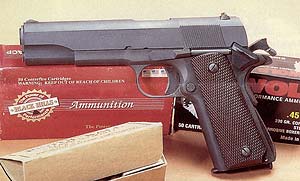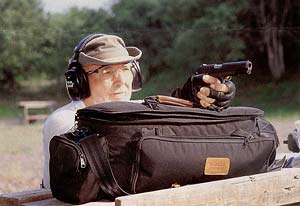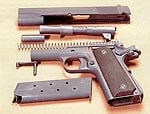S.W.A.T., Nov. 2002, Page 42-45
By Walt Rauch
Looking at the new Auto-Ordnance 1911A1 I wondered if anyone needs or would want yet another “plain-Jane” 1911A1. I thought to myself I have at least a half-dozen GI 1911s and they were all cheap. I reflected that during my college years as an NRA member I could (and did) buy a “Serviceable Grade” 1911 (meaning ready for re-issue to military forces) from the Director of Civilian Marksmanship (DCM) for $34.50. If you wanted to gamble on what you would get, you could opt for an “Unserviceable Grade” gun for $17.50 (meaning possibly missing some small parts).
I bought the Serviceable Grade while others went for Unserviceable guns. Most often, the only difference was that the latter had some surface pitting that hadn’t been buffed out. Both grades had been rebuilt at government arsenals prior to storage, although once in a while some lucky NRA member would get a brand-new original 1911 or A1 at the Unserviceable price. Both of mine shot quite well. (Of course, time does have a way of making what I did and how well I did it remember “better”.) In gun shops, GI guns went for about $37.50, while new Commercial Colts were $78 and used ones ran $55 plus change.
As I thought about this, I also realized that forty years have gone by. The DCM is long gone, replaced by a private company, the Office of Civilian Marksmanship Program, and the “gun grabbers” stopped government-sponsored handgun sales a very long time ago. Also, there aren’t any “cheap” GI 1911s for sale and the ones that would rate NRA-excellent grade run in the $1,000 range. Uh huh. There just might be a market for an American-made, standard 1911 at a reasonable price.
Now the job was to see if the Auto-Ordnance 1911 benefited from being made under the direction of Kahr Arms, which recently bought the company. Prior to the new owners, AO guns had less than a sterling reputation for quality – and that’s putting it nicely. I know more than a few gunsmiths who refused to work on them. Since Auto-Ordnance and Numrich Gun parts shared a common town – West Hurley, New York – it’s no stretch to figure out that the previous AO guns were primarily assembled from surplus parts…the operative word being assembled (read just put parts together). The ones I’ve examined showed they had received little if any attention to such niceties as seeing that parts mated up well with each other. The Unserviceable Grade guns of old were a better gun by far.
For instance, I had an AO 1911 for a test of a Gun Parts, Inc. aftermarket barrel (Gun Parts is the successor to Numrich) chambered for .400 Cor-Bon. The gun worked well with .45 ACP ball ammo and the T&E .400 Cor-Bon barrel dropped in easily and also worked. The pistol just wasn’t very nice to look at.
The new Auto-Ordnance 1911A1 is well-made. The Kahr Arms supervision shows and the company is doing it right – except for the name. The new gun should have been (and maybe yet) dubbed the Kahr Arms 1911A1, losing once and for all the baggage that accrued to the old AO 1911 guns.
Out of the box, the new AO 1911A1 looks to be a newly-manufactured twin to those 1911A1s made at the beginning of World War II, with some small changes. In the new AO gun, the parts fit right save for the WWII grooved mainspring housing that has a few gaps in its fit to the receiver.
The AO 1911A1 is available with three finishes: Parkerized, standard and deluxe blued. My sample was Parkerized so I thought it would be informative to see just how faithfully the AO gun follows those made during the WWII era. To do this I used what I consider to be the definitive text on the subject, Charles W. Clawson’s book, Colt Service Pistols, Models of 1911 and 1911A1 (available from Charles W. Clawson).
Starting with the AO’s Parkerized finish, the reference work notes that Colt used Parco-Lubrite finish, a manganese-based phosphating process, while Parkerizing uses a zinc base. Both were developed by the Parker Rustproof Company of Detroit, Michigan. (The more familiar green-hued phosphate finish found on U.S. military arms came later.)
The AO’s seven-round magazine differs from the familiar GI design, although retaining the flat-shelf follower which has a raised dimple in its center for enhanced feeding. The AO magazine is made by Metalform and has a removable metal base plate. The Metal Form Corporation made magazines during WWII, although I am unable to establish a linkage between the early and the current firms.
The AO slide serrations are forward-slanted in the style of Drake-manufactured National Match slides and the commercial Colt Gold Cup model, as compared to the vertical grooves of CI and standard Commercial Colts. The ejection port window is lower (that is, larger) than in the WWII guns. This is a benefit for reloaders, because the original, smaller port dents the mouth of the ejected case.
The AO 1911A1 uses a long, grooved, solid steel 1911 trigger sans overtravel screw, rather than the short, stamped 1911A1 trigger. Many users will choose this long trigger anyway. The frame is scalloped behind the trigger guard as is normal for 1911A1 pistols. The AO hammer is very similar to the short, wide Colt hammer adopted in 1939. The plastic grip panels follow the style of the Key Fibre Company-manufactured plastic grips that were made with small reinforcing rings around the screw holes and reinforcing ribs on the interior surfaces. Also, according to Clawson, the Colt WWII mainspring housing had seven grooves and lanyard loop and the AO is identical.
The AO thumb safety is of the post-WWII design – a full shelf on a plate, grooved and rounded, as opposed to the GI “stub” design. Internally, the parts are standard 1911A1 except that the barrel chamber mouth is throated from the 4 o’clock to 8 o’clock area. The recoil spring feels to be a 17-pound spring. (Current Colt springs run 16 pounds). Cocking the hammer, the mainspring seems lighter than the WWII guns, but about what is found on today’s commercial 1911A1.
I’ve had this gun out to the range on three occasions and it hasn’t failed to function and fire with any of the loads we used. I started with PMC and Winchester WEstern 230-grain JRN and worked my way though a menu of bullet shapes, weights and velocities, all of which worked. I thought this was commendable and happened to mention it to my friend and fellow gunwriter Frank James, who was also testing an AO gun. He said this had not been his experience. His sample didn’t work reliably with some of the same brands of ammo that I fired, so there seems to be a possibility of inconsistent assembly or barrel throating.
Each time I shot the gun conditions were ideal, with lots of sunshine to see the small sights. The trigger pull was, well, GI, breaking at six pounds and a bit gritty. The twenty-five yard accuracy was only dependent on how well I could see the sights and work the heavy trigger. If everything meshed, the gun shot five rounds into three-inch groups over a supported rest. I had particularly nice groups with the Hornady 200-grain JHP as well with ProLoad Tactical 200-grain JHP +P. I also shot Remington Golden Saber 185- and 239-grain JHP as well. I then moved to Triton 185-grain +P JHP and the Cor-Bon 165-grain +P JHPs. The AO’s heavier-than-standard spring helped in sight recovery, as the hot loads do give a bit of muzzle lift to the gun. I used the Metalform mag throughout and the gun locked open, as it should, every time.
I was reluctant to do any really fast shooting drills because I already have enough of a scar in the web of my hand from “hammer bite” caused by the hammer pinching the skin between it and the grip safety when using a high hold on the gun. (This was particularly egregious with the original 1911, before the A1 modifications done in 1925.) I did do some draw-and-fire work and, being careful, came away unbloodied, as it were. Does the AO need a wide beavertail grip safety? Depends how you grip the gun. This is, after all, a basic gun and sold at an affordable price. You can add to it or have work done to it as your budget or fancy dictates.
What we have after all this is a well-made 1911A1 that follows the original WWII design with the few added improvements that enhance function. Yes, a plain-Jane, no-frills 1911A1, suitable for personal defense, a nice gun to take to the range or to just have. If you want a more “real” WWII gun, there are any number of sources for GI thumb safeties and a short, round GI trigger. The Auto-Ordnance from Kahr Arms is good “as is” or can be used as a solid platform on which to add those items you consider necessary for the perfect enjoyment of this classic design. For instance larger sights, beavertail grip safety and some change to the front strap such as checkering, grooving or stippling (a piece of skateboard tape will do) for a more secure grip. Of course, there’s a plethora of wooden checkered grips for the 1911 genre at a price that shouldn’t hurt anyone’s wallet. All these potential changes are why the 1911 is similar to a Harley motorcycle – no one leaves them stock!
The new Auto-Ordnance 1911A1 is shipped with one magazine in a hard-sided case accompanied by the now-obligatory cable lock, as well as warranty, a must-read instruction book and a GI-type bronze brush on a twisted wire shaft. As mentioned earlier, AO 1911A1 come in three grades: WWII Parkerized, Standard and Deluxe blue. The Standard gun is blued, while the Deluxe is blued with high-visibility three-dot sights and wrap-around rubber grips. They are priced at a suggested retail of $462, $447 and $455 respectively.







